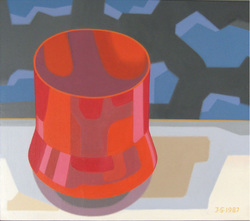|
In the early 1990s this was given first as a speech to a class at the Lancaster County Art Association, and in briefer form afterwards on a couple of other occasions. Some of the illustrations come from the text, others from references to physical works that Johannes brought with him, and one from live demonstration. (FIRST of eleven sections) I The Artifact and the Art Object A. Rules for Right Making in Utility and Art In past times distinctions were drawn between products of the Fine Arts and humble Objects of Utility, adding to the latter ever the inferior rank. Much thinking in this century turned this around, proclaiming the well-made artifact the equal of the work of art and, in all essential ways, indistinguishable from it. The difficulty may not be amenable to any final settlement. There is a common good desired of them both: We want our furnishings as well as our pictures to be beautiful. But their capabilities and purposes can also differ widely; and that needs to be accounted for before this search for understanding ends. Yet, for our start it will be helpful that the ground rules for creating a good product govern equally the object of utility and one existing solely for its beauty – the Applied as well as the Fine Arts. B. John Benson’s Course and the Twin Purposes of All Instruction Undergraduates at Rhode Island School of Design in the 1950s studied during one semester a subject called Philosophy of Design. The course was taught by a great man, John Howard Benson. It was beautifully organized, and ably introduced us to a domain of intellectual concern that few artists ever get to know. Also, it fulfilled better than most others the twin purposes of all instruction:
C. Ways of Delivering the Wrong Results When an otter lies upon its back and opens a mussel by breaking the casing with a stone, or a raptor rises to some height and drops its catch to shatter on the ground below, or again, an early hominid seized a rock to cleave with it the brain-case of his game, the deeds appear identical in their complexity of mental action. But they are most dissimilar in their cultural and, in the end, historic consequences. Man alone evolved to overcome, to an extent, the specific limits all other species failed to breach. These, however, remain the causes of inferior work at the hands of man, to the present day. They are:
D. The Worthwhile and Essential Callings of Man’s Life
E. The Causes of Things Made There are reasons, or causes, why Man-Made Things Exist
and of the materials to each other. Techniques are the union of the Material and Efficient Causes. Materials properly chosen for their purpose are shaped according to what the right tools and materials can suitably be made, and want, to do for a desired end. 4. Formal Cause: The solution of the problem and its final form are achieved in Stages. The Stages are reductions, that is, Abstractions derived from the problem posted by the patron. Stages constitute the successive images to which the materials must by shaped. [Other Causes than those cited as Antecedents of Results –from notes at end of essay:
F. Stages as Instrumental Intermediate Forms
knowledge, will, and skill, but also inventive sensibility, is brought to bear to set the correct milestones in their places as the Work Path gradually unfolds. It is here, when we must rely on our uncertain intuitions, that we cannot altogether escape our own uneasiness of mind. 3. The last of the abstractions that we call a Stage is the Final Form and conclusion of the worker’s effort. It represents perfection as a thing complete and thoroughly constructed. Perfection is here not an attribute divine, but must be rightly understood as a property of man-made things within their range of possibilities, that is, within the impediments or limits of the job. When the last possible duty is faithfully performed, perfection as achieved because we can do no more – the final chore and last detail. Comment:
Perhaps you can comment from work you have done in Arts, Crafts or other projects using Stages as Intermediate Forms . . . .
0 Comments
|
A Blog containing longer text selections from essays by Johannes, on art, philosophy, religion and the humanities, written during the course of a lifetime. Artists are not art historians. People who write are not all learned scholars. This can lead to “repeat originality” on most rare occasions. When we briefly share a pathway of inquiry with others, we sometimes also must share the same results.
Categories
All
Archives |
| von Gumppenberg | Johannes Writes |
|
|








 RSS Feed
RSS Feed